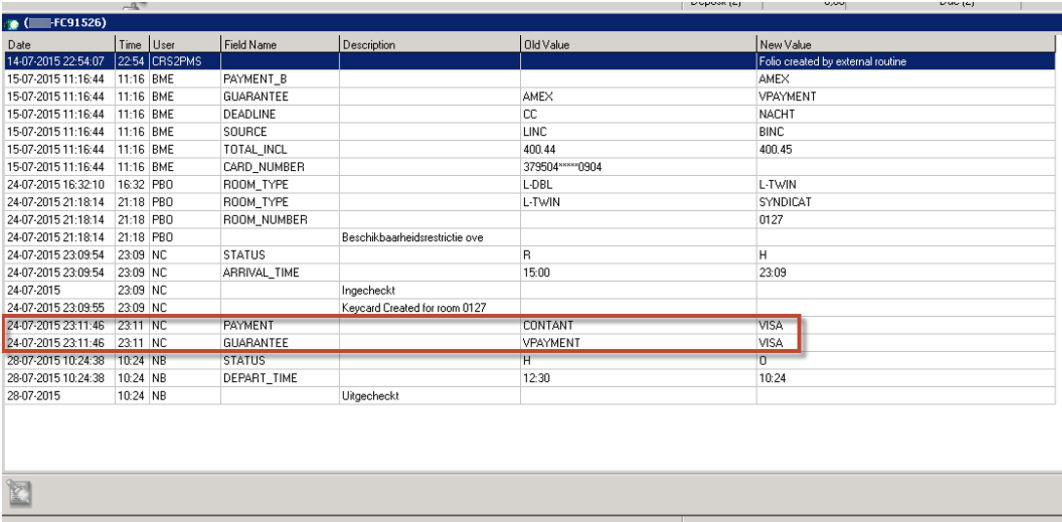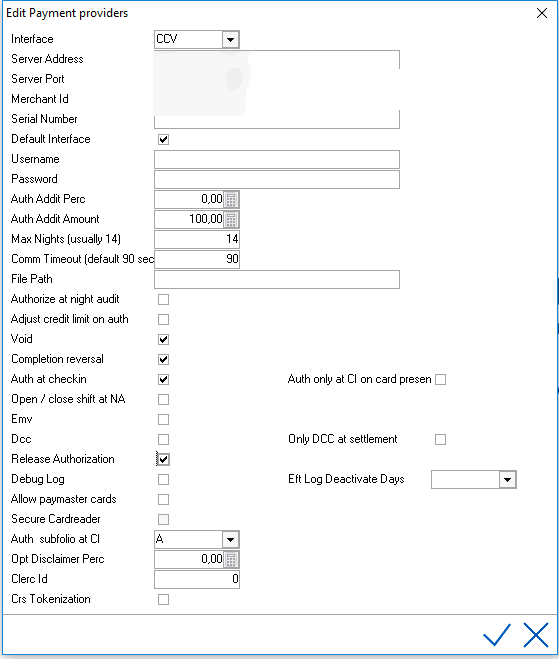
This chapter includes:
- Payment Provider
- Credit card terminal
- Articles
- EFT card type
For the integration with CCV, a payment provider is set-up in IDPMS. Through this payment provider IDPMS communicates with the CCV server.
This payment provider is also linked to the payment articles used for CCV transactions.
Settings > Interfaces > Payment providers
Double click on the payment provider CCV to access the settings:

Server address and Server port
IDPMS communicates with the CCV server (Windows service) installed on this IP address and port.
Merchant id
The merchant id is the id of the hotel. Each hotel has its own unique id. The merchant id is received from CCV at installation. Important for communication.
Serial number
Unique hotel identifier for acquirer. Received from CCV. If incorrect, acquirer pays transactions to another hotel.
Default interface
Indication of the leading payment provider. Some hotels have more than one payment provider. The default payment provider is used for top-ups during night audit.
Username and password
Received from CCV at installation.
Auth Addit Perc
Additional percentage authorised at check-in (extra deposit). Additional percentage on top of the authorization. This is a percentage of the entire stay, on the subfolio set–up in the payment provider CCV. In this example, subfolio A:

This extra amount will be authorised at check-in for extras like mini bar charges, restaurant bills, phone charges, etc.
For example additional percentage 10%. Reservation for €200 on subfolio A means €200 + 10% = €220 will be authorised at check-in.
Auth Addit Amount
Just like the additional percentage, an additional amount can be set-up. This extra amount will be authorised at check-in for extras like minibar charges, restaurant bills, phone charges, etc.
For example additional amount €50 for each reservation. Reservation for €200 means €200 + €50 = €250 will be authorised at check-in.
Max Nights (usually 14)
Maximum number of nights that will be authorized at check-in. Used for calculating the total amount to authorize at check-in for each reservation.
For example used for long stay guests. If the total stay will be authorized, the credit card needs to have a high limit. If 1 is entered, only the first night will be authorised.
Comm Timeout (default 90 sec)
Time IDPMS is waiting for a response from CCV server. Default 90 seconds. After 90 seconds a time out message is displayed.
File path
Not used for CCV.
Authorize at night audit
Top-up authorisation during night audit, for the amount on the folio. Top-up authorizations are “card not present” transactions and therefore no EMV transactions. If enabled, the authorized amount is increased during the night audit to equal the balance of the reservation. For example €100 authorized at check-in. The balance on the reservation is €150 during night audit. A top- up authorization of €50 will be made.
Adjust credit limit on auth
In IDPMS it is possible to set up a limit (amount) to which the card is guaranteed. The guest can for example have restaurant tickets charged from POS to IDPMS till this limit is reached.
Usually, this setting is not enabled.
If enabled, the credit limit in the reservation is adjusted automatically once any changes occur in authorised amounts on the folio.
Void
Not used for CCV.
Completion reversal
Not used for CCV.
Auth at check-in
If enabled, the authorisation screen will pop-up automatically at check-in. The guest will be asked to insert his credit card in the credit card terminal.
Auth only at CI on card present
Old setting. Not used for CCV.
Open/ close shift at NA
Not used for CCV.
EMV
Not used for CCV.
DCC
Not used for CCV. Obsolete setting in IDPMS since this is always enabled for CCV (standard parameter integrated on terminal).
Release authorization
an authorisation is a reservation on the guests’ credit card. Normally this reservation is hold for approximately 30 days, which means the guest can’t use this amount for other purposes. With the setting ‘release authorisation’ this authorisation can be released earlier. The guest doesn’t have to wait for 30 days before the authorisation is released. The number of days is configurable. The setting can be found:
Settings > Option > Third party and interfaces:
+ Third party and interfaces
+ Global credit card settings
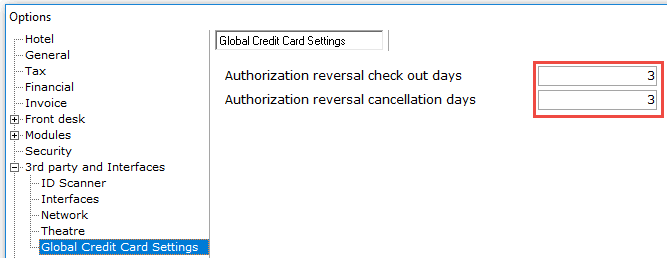
Num days credit card reversal. In above example three days after check out and three days after cancellation date. This means three days after check-out/ cancellation of the reservation, unused authorisations will be reversed by IDPMS.
Debug log
if enabled, a log file will be created which contains the transactions from IDPMS to the windows service (CCV server) and the response message from the CCV server.
The log file will be saved in the IDPMS data folder.
This logfile is called EFT_debug.log. By default the log should always be disabled. If an issue is reported, the debug log can be enabled temporarily so the problem can be monitored.
Allow paymaster cards.
Allow to charge credit cards on paymasters. For example when a guest from the hotel restaurant wants to buy a newspaper at reception and pays with his credit card.
Secure cardreader
Greyed out, option not used for CCV.
Auth subfolio at CI
Subfolio that IDPMS will use by default to calculate the amount to authorize at check-in.
For example subfolio A. A reservation has a charge routing set-up. Room and breakfast is routed to subfolio B and will be paid by company. All charges routed to the company don’t need to be authorised on the guests’ credit card. An authorisation needs to be made only for expected extras.
Opt. Disclaimer Perc
Disclaimer percentage in the bottom text on the invoice.
When using DCC, 3% extra will be charged if the customer pays in his own currency.
Will be displayed on the invoice.
Clerc id
not used for CCV.
This option allows workstation-terminal mapping. Go to Settings > Interfaces > Credit Card Terminal.
For example:
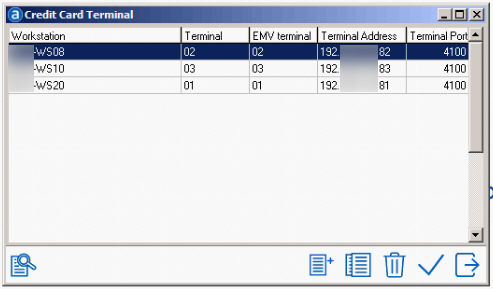
Workstation
All workstations that should be able to process credit card transactions need to be added here. It is also possible to map multiple workstations to one payment terminal.
In case of a terminal server environment, the pc name and client name are not equal.
Make sure to map the client pc name and not the terminal server name. To find out the client name, go to Settings > Options > Printers and check the local settings. For example:
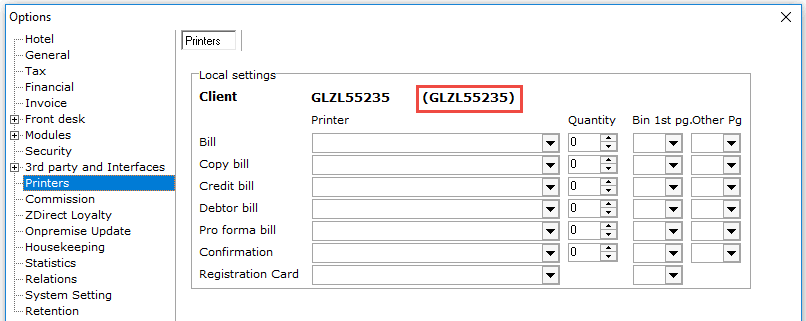
Terminal
Unique number must be entered.
EMV terminal
Unique number must be entered.
Terminal address
The terminal address is the ip address of the CCV terminal.
Same IP address means the same terminal is used for multiple workstations.
For example at reservations department. Several workstations use only 1 CCV terminal because reservations department doesn’t need the terminal for each reservation.
Terminal port
Default port used is 4100.
Settings > Financial > Article
Payment articles used for CCV transactions must be configured as EFT articles. Hotels that use CCV, have both EFT articles and Non-EFT (manual or offline) articles.
The EFT articles are used for the transactions through CCV, manual articles are used for corrections or in case the interface between IDPMS and CCV is not working properly.
EFT articles:

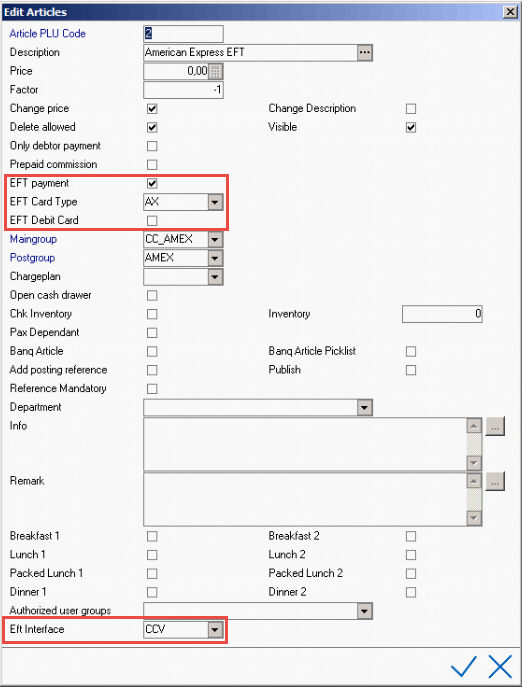
Manual/ offline articles:
In Settings > Interfaces > EFT Card Type the EFT card types are defined. This table is used to reverse lookup the card type used by the guest. The payment completion received from CCV contains the real card type used by the guest. With this card type, the correct EFT article will be used for the payment.
For example, at check out the front office employee is posting a payment in IDPMS with article PLU 2 (AMEX) but the guest inserts a Visa card instead. IDPMS receives the EFT Card Type VX from CCV. Because this card type is present in the EFT card type table, IDPMS can use the correct payment article.
Example:
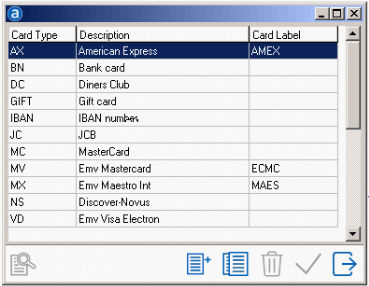
If IDPMS receives a card type which doesn’t exist, the message ‘No EFT card type found’ will be displayed. If this happens, the payment article chosen in IDPMS will be used.
For example, the IDPMS user posted PLU VISA, while the guest inserts an Amex (AX). If the card type AX is received but not set-up in IDPMS the message ‘No EFT card type found’ will be displayed and the payment will be posted as a VISA payment. Make sure to add the missing card type in IDPMS.
The EFT card type is linked to the payment types in IDPMS via this PLU.
For example, a reservation is made with payment type ‘CONTANT’ and guarantee ‘VPAYMENT’.
At check-in, the guest inserts a VISA card for the authorisation at check-in. IDPMS receives the card type VX:

The linked payment type is VISA (PLU 4) Settings > Financial > Payment type:
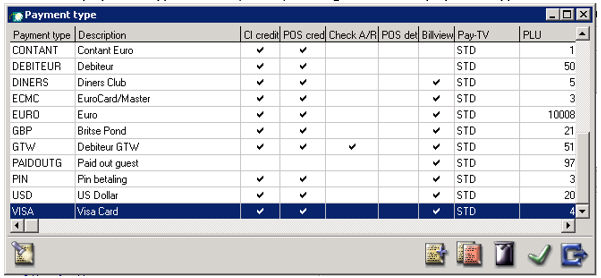
The guarantee is VISA, Settings > Reservations > Guarantee:

The reservation will be changed automatically:
